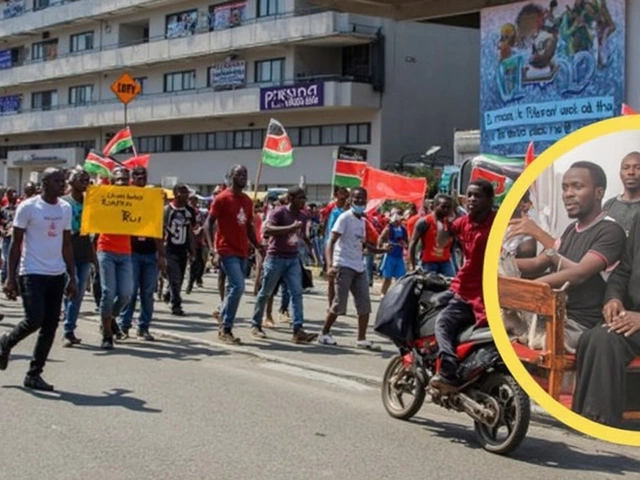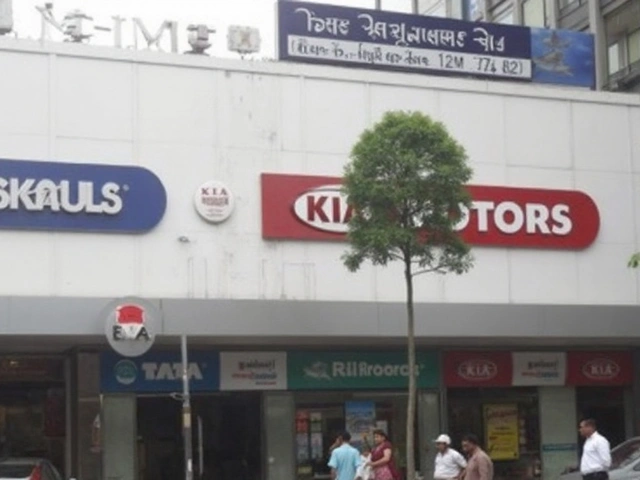When Snapchat went dark on the morning of October 20, 2025, millions of users thought they were the only ones stuck staring at a blank screen. The reality? A cascade of failures across the cloud that knocked out everything from Fortnite battles to banking apps, all traced back to a single hiccup in Amazon Web Services's US‑EAST‑1 region. By 3:50 a.m. Eastern, DownDetector logged a peak of 22,762 simultaneous reports – a digital panic that rippled across continents.
What Went Wrong? The AWS Fault Line
According to the AWS Health Dashboard, the issue began at roughly 3:11 a.m. ET (7:11 a.m. UTC) when the provider started seeing "increased error rates and latencies" across multiple services in its US‑EAST‑1 data centre. The root cause? A DNS (Domain Name System) malfunction that garbled the translation of web addresses into IP addresses, effectively sending traffic into a black hole.
Technical analysts from The Los Angeles Times explained that DNS is the internet’s phone book. When that book gets a typo, every call is mis‑dialed. The outage wasn’t limited to Snapchat; the same DNS glitch throttled access for platforms that rely on the same AWS backbone.
Snapchat and the Snowball Effect
Snapchat users first reported login failures and a cryptic warning: "Due to repeated failed attempts or other unusual activity, your access to Snapchat is temporarily disabled." By 4:00 a.m. ET, the problem had spread from New York City to the West Coast, with spikes in San Francisco and Los Angeles. The platform’s Snap Map, Stories feed, and direct messages—all fell silent.
Why did this matter to everyday folks? For teens skipping school, for journalists sharing breaking news, for businesses using Snap Ads to reach customers – the outage hit both personal and commercial realms. In a world that’s increasingly mobile‑first, losing a primary communication app for three hours feels like a power cut in the digital age.
Collateral Damage: A Who‑What‑Where Roll‑Call
While Snapchat was the headline, the domino effect engulfed a laundry list of services:
- Gaming: Fortnite, Roblox, and Clash of Clans froze mid‑match.
- Finance: Coinbase and Robinhood blocked trades, sparking frantic calls to customer support.
- Social: Facebook and Reddit showed "loading" spinners for minutes.
- Communication: Signal and Zoom reported failed connections for remote workers.
- Travel: Delta Air Lines and United Airlines saw booking glitches.
- Telecom: AT&T customers experienced slow data speeds.
- Education: Duolingo lessons failed to load for language learners worldwide.
- Smart home: Ring doorbell alerts were delayed, raising security concerns.
Even the U.K. government wasn’t spared. HMRC’s online tax portal and the main Gov.uk site went offline, prompting a spokesperson to tell Sky News, "We are aware of an incident affecting Amazon Web Services, and several online services which rely on their infrastructure…"
Reactions from the Front Lines
Companies took to X (formerly Twitter) to confirm the outage. Elon Musk, the billionaire behind X.com, posted a terse "X works" at 9:18 UTC – a tongue‑in‑cheek nod that his own platform remained functional despite the cloud turbulence.
Snapchat’s head of product, Mike Murphy, later issued a statement acknowledging the outage and promising a post‑mortem, but he stopped short of assigning blame, noting that the "issue originated from a third‑party provider beyond our immediate control."
Meanwhile, Amazon Web Services posted updates every 30 minutes on its status page. By 6:15 a.m. ET, the provider claimed “partial recovery” and warned that full restoration could stretch into the afternoon as engineers rewrote DNS routing tables.
Why This Matters: The Cloud‑First Reality
The outage underscored a growing truth: almost every digital experience today rides on a handful of cloud giants. When AWS hiccups, the ripple hits schools, hospitals, airlines, and even government agencies. Analysts from TIME warned that the incident should prompt a rethink of “single‑vendor dependency” strategies, especially for critical public services.
Security experts also pointed out that DNS failures can be exploited for phishing or man‑in‑the‑middle attacks, though no malicious activity was reported during this event.
Looking Ahead: Mitigation and Redundancy
In the weeks following the outage, several firms announced plans to diversify their cloud footprint. Coinbase said it would pilot a backup node on Microsoft Azure, while the U.K. Home Office pledged to audit its reliance on any single cloud provider.
For everyday users, the lesson is simple: keep backup apps handy. If Snapchat is gone, a few seconds of a traditional SMS can keep the conversation alive. For businesses, a multi‑cloud or hybrid approach could be the difference between a brief glitch and a revenue‑killing shutdown.
Key Takeaways
- Outage started at 3:11 a.m. ET in AWS's US‑EAST‑1 region, caused by DNS routing failures.
- Snapchat, Fortnite, Coinbase, Reddit, and many more services were affected worldwide.
- Peak of 22,762 simultaneous reports logged by DownDetector.
- U.S. East Coast accounted for ~50 % of global outage reports.
- AWS began partial recovery after roughly three hours; full restoration stretched into the afternoon.
Frequently Asked Questions
What caused the Snapchat outage on October 20, 2025?
The outage was traced to a DNS malfunction in Amazon Web Services' US‑EAST‑1 data centre. When DNS failed, the internet couldn’t translate Snapchat’s server addresses, preventing users from logging in or loading their feeds.
Which other services were impacted by the same AWS failure?
Besides Snapchat, the glitch hit gaming platforms like Fortnite and Roblox, financial apps such as Coinbase and Robinhood, social networks Facebook and Reddit, communication tools Signal and Zoom, travel carriers Delta and United Airlines, and even U.K. government portals like HMRC and Gov.uk.
How long did the outage last?
AWS reported partial recovery after about three hours, around 6:15 a.m. ET. However, some services continued to experience intermittent issues well into the afternoon, with full restoration taking most of the day.
What does this incident mean for the future of cloud reliance?
The outage highlights the risks of single‑vendor dependency. Companies and governments are now reconsidering multi‑cloud or hybrid strategies to ensure continuity if one provider experiences a fault.
Did any notable figures comment on the outage?
Elon Musk, owner of X.com, posted a brief "X works" tweet at 9:18 UTC, underscoring that his own platform remained operational despite the broader cloud disruption.







Chandra Soni
Wow, the AWS hiccup really spotlighted the need for a robust multi‑cloud strategy. By leveraging redundancy across providers, businesses can mitigate single‑point‑of‑failure risks and maintain SLA compliance. It’s all about elastic scaling, fault‑tolerant architectures, and diversified DNS routing. The tech stack community should push for cross‑region failover drills ASAP.
Kanhaiya Singh
The outage was undeniably disruptive, and its impact on daily digital workflows was profound. While the technical details are intricate, the broader implication is clear: reliance on a solitary cloud vendor introduces systemic fragility. A measured approach to redundancy is advisable.
prabin khadgi
One must contemplate the philosophical ramifications of entrusting critical infrastructure to a monolithic entity. The assertion that diversification equals resilience is both logical and empirically supported. Hence, enterprises ought to adopt a multi‑provider paradigm without delay.
Aman Saifi
The incident certainly raises questions about cloud strategy, and I think an open dialogue is essential. Exploring hybrid deployments could balance performance with safety. It’s worthwhile to assess risk tolerance before committing fully to any single platform.
Arundhati Barman Roy
The AWS DNS glitch served as a stark reminder of how interwoven our digital ecosystems have become.
Even though the root cause was a simple misconfiguration, the cascade effect was anything but trivial.
Businesses that had not invested in backup routing found their services abruptly inaccessible.
It is evident that a single point of failure can cripple sectors ranging from entertainment to finance.
Moreover, the lack of transparent communication initially left many operators in the dark.
Customers experienced prolonged downtime, which eroded trust.
In hindsight, routine failover drills could have mitigated the fallout.
System architects should prioritize multi‑AZ and multi‑region redundancy.
Furthermore, DNS health monitoring must be continuous rather than periodic.
The incident also highlighted the need for diversified vendor strategies.
Relying wholly on AWS without auxiliary pathways proved risky.
Adopting a hybrid cloud model offers both flexibility and security.
Policy makers might consider mandating resilience standards for critical services.
In the aftermath, several firms announced plans to diversify their cloud footprints.
Overall, the episode underscores the importance of proactive risk management.
yogesh jassal
Well, at least we got a taste of the apocalypse and survived, right? It’s funny how a DNS typo can turn the whole internet into a ghost town. Maybe now we’ll finally see more folks keep a backup chat app on hand. Cheers to learning the hard way!
Raj Chumi
Can you imagine the drama when the screen just stays white? Total chaos lol
mohit singhal
Our nation’s digital pride was dragged through the mud – this is why we need homegrown solutions! 🚀🌐
pradeep sathe
I felt the frustration just as badly as anyone else, but we’ll bounce back. Stay hopeful!
ARIJIT MANDAL
You should have known this would happen.
Aditi Jain
Obviously, only a nation‑first approach could have prevented this debacle. Our tech ecosystem must rise above foreign dependencies.
Yash Kumar
Everyone’s hailing the cloud as the answer, yet here we are watching a single DNS slip cause chaos. It’s ironic, isn’t it? Maybe we need to rethink the hype.
Aishwarya R
Did you even read the post? It’s obvious.
Jenisha Patel
While the outage was undoubtedly inconvenient, it also offers an invaluable lesson, namely, that over‑reliance on a single provider can jeopardize operational continuity; therefore, stakeholders should prioritize diversification, and implement rigorous testing protocols to safeguard against similar future incidents.
Ria Dewan
Ah, the cloud-so mighty, yet so fragile. Guess we aren’t gods after all.
rishabh agarwal
It’s a reminder that tech glitches happen, nothing more, nothing less. Let’s keep calm and plan ahead.
Apurva Pandya
Morality dictates we must push for stronger safeguards. 😊
Nishtha Sood
Keep your heads up-every setback is a setup for a comeback. Let’s learn and move forward together.
Hiren Patel
Man, the whole thing felt like a wild roller‑coaster of panic and memes. Still, we survived and now we have stories to tell! 🎢
Heena Shaikh
Such outages prove the illusion of digital omnipotence.